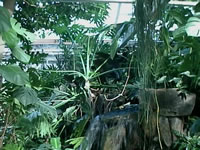 |
There are no hard and fast rules to watering, because every situation is different,
due to temperature variations, humidity and soil types etc.
It is better to keep an indoor plant on a slightly dry side than over watered.
More houseplants die from over watering than any other cause!
Never allow your House Plant to stand in a saucer of water for more than an hour or two!
City water is treated with chemicals for your safety, however most House Plants don't like chlorine or fluoride,
so it's a very good idea to allow the water to sit in an open container for at least 24 hours prior to using it for watering.
This is enough time for the chemicals to dissipate and evaporate from the water and bring the water up to room temperature.
Even though my water comes from a mountain spring, I still keep a couple of gallon milk bottles filled for watering,
so it is warmed to room temperature before I use it.
Personally, I don't like cold water dumped on me... Do you?
|
|
Lighting Requirements for Your House Plants
The amount and the intensity of the light that the plant receives dictates much of a plant's life cycle.
Even though a plant species that may have originated in a jungle where it thrives in the shade of trees, appears to be getting plenty of light, the intensity of the light indoors may be much lower than what the plant actually needs.
Insufficient light usually manifests itself with paler foliage, lanky growth, and general lack of luster.
When this happens you must do whatever you can to increase the light intensity for that plant.
This can usually be rectified by moving the plant closer to the window,
or moving it to another room with different light exposure.
When you change the light drastically for a house plant, do it gradually to accustom them to the brighter light.
Plants will sunburn if they are put into too bright of a light after their skins have become tender from lack of light.
Plants should never be placed between a curtain and the window if the nights are cold,
even if they are sun lovers.
It is better to have a sheer curtain that will admit the light,
and have the plant in the heated area.
Growing HousePlants Under Artificial Grow Lights
|
It isn't necessary for your plant to even know that it is winter.
You can dictate many of your plants functions by giving them supplemental, artificial light.
There are 'grow lights' on the market today that successfully imitate the same light spectrum of natural sun.
These flourescent lights aren't perfect, and if they are the sole source of lighting,
it will be necessary to have them on for 12-16 hours each day.
It is a good idea to have them set on a timer so that the light hours are regular.
If your intent is just to fool your plant into thinking that it is a certain season for blooming
or whatever reason, you can set the timer to come on as the light begins to fade,
and make your house plants day as long as you'd like.
|
|
Many flowering and foliage plants actually grow and look better indoors when grown under artificial lights.
Keep in mind that plants like to rest now and then too, so if you are using growing lights,
cut back the hours now and then and let your plants have a temporary period of dormancy.
Most House Plants Require a Period of Dormancy
Plants sense the natural shortening of daylight hours and may go dormant as they would in their natural habitat.
This is usually a time when the amount of watering is decreased.
On the other hand, many plants actively begin to grow or bloom, so they must have more water, and be fed.
While plants are dormant they should only receive a minimum amount of water each time
and only then if the soil becomes dry to the touch an inch below the surface.
Temperature, Humidity and Fresh Air Requirements
Proper lighting and watering are, by far, the most important criteria for the health of your house plants,
but temperatures and humidity will drastically affect your plants health as well.
House plants, even though they may be of a tropical nature would rather sacrifice a few degrees of temperature
in the home than the moisture in the air which they need to survive.
Even though your plant may prefer a warmer situation, it sometimes comes down
to accepting the lesser of two evils; cool temps or lack of humidity.
Heated rooms, by nature tend to be dry rooms, especially if they are heated with forced air, or fire.
Even rooms that have steam or hot water radiant heat will be somewhat dryer.
If you want your plants to succeed, keep your temperatures as low as possible,
while still remaining comfortable for yourself, but never below 50°.
Generally, tropical plants enjoy a relative humidity of 50%-70% and warm temperatures.
Unfortunately, when temperatures in the home rise above 67° F., the humidity drops drastically,
so it may be necessary to sacrifice a few degrees of warmth in lieu of an increase in the humidity.
Provide additional humidity by setting the plants on shallow trays filled with moistened pebbles,
a humidifier or aquarium, especially during the winter months. Frequent misting will help considerably.
Keep in mind that because glass is a poor insulator, the temperature near windows will be considerably colder.
At night, be sure to close the drapes or move the plant to a warmer part of the room.
Some Exceptions to the Rules
Succulents being the most notable exception, in that they prefer warmer and drier conditions.
At temperatures below 60°, African Violets will stop blooming, Poinsettias may drop their leaves, and the leaves of Gardenias may turn yellow.
I recommend reading Diagnosing HousePlant Problems and The Bug Page
for more tips about keeping your house plants happy and healthy!
|




